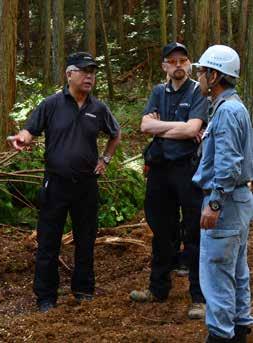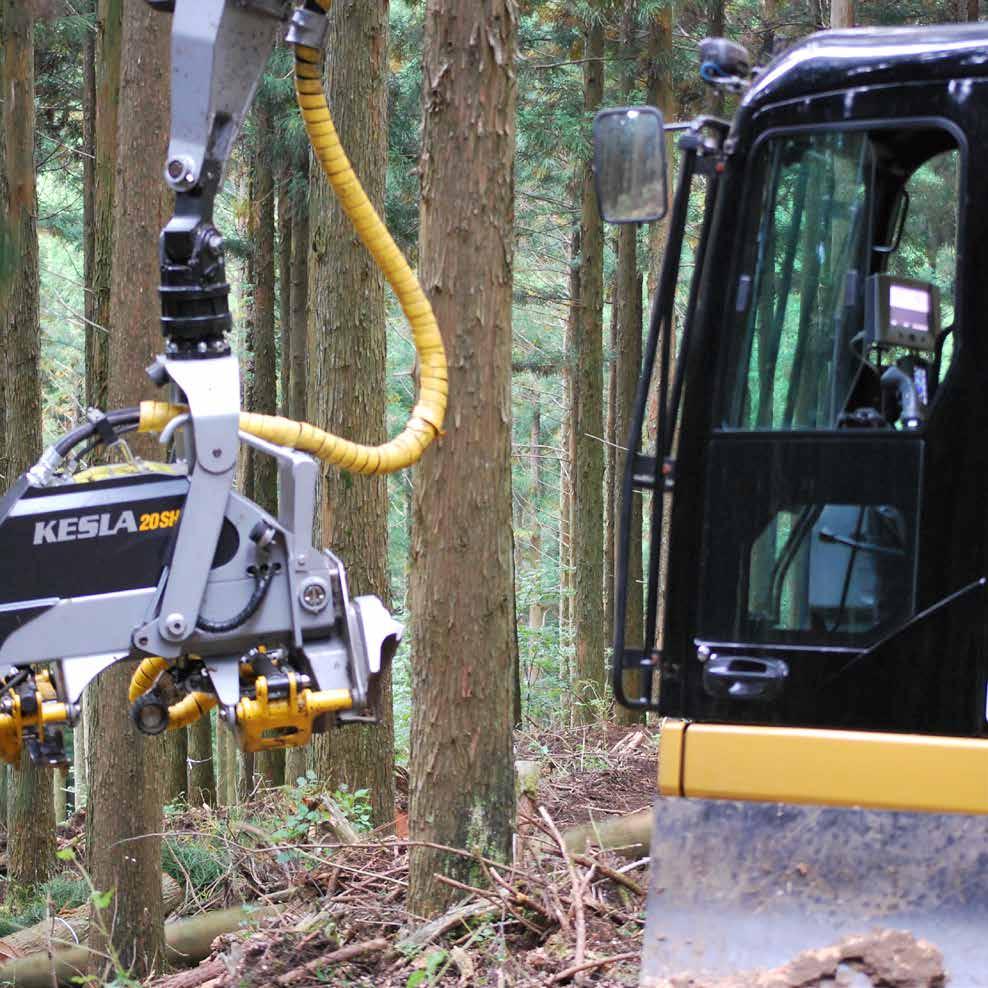
7 minute read
You can always ask
Hiro (left) and Mika Tahvanainen (right) during a customer visit in Japan.
In 2007 Kesla had good news from Japan. The company signed a cooperation agreement with Japanese Sumitomo (S.H.I.) Construction Machinery Sales Co. and Usui Automechanic Shop. Sumitomo is one of the leading excavator manufacturers in the world. There was a reason why everyone at Kesla was so excited. However, there was one final hurdle – or rather, one clarifying question.
Around 40% of Japan’s forests are planted stands, the majority of which have been planted since the Second World War. Japan’s forests – more than 6 billion m3 of forest resources – grow in mountainous areas, where the terrain is difficult to navigate and annual rainfall can often reach around 1,500 mm. There are therefore many challenges in the harvesting conditions.
In the mid-2000s, Sumitomo produced more than 10,000 excavators per year. At the same time, a forest programme with a strong increase in timber harvesting volumes was launched in Japan. The Japanese wanted to develop a factory-fitted crawler harvester suitable for modern timber harvesting. A delegation came from Japan to Finland in search of a forest technology partner. The Japanese were looking for a small harvester head on the market that would be best suited especially for harvesting hinoki cypress. Hinoki cypress is a valuable coniferous tree species in Japan that grows on drier land than its sister species Japanese cedar. All parts of hinoki cypress, from bark to pith, are used, and harvesting must leave no marks on the wood. The Japanese delegation visited Kesla’s Kesälahti factory. Mikko Lehikoinen, Marketing Manager at the time, asked Export Manager Mika Tahvanainen in passing to escort the delegation to Joensuu Airport for their trip home. Tahvanainen had not participated in any indepth discussions with the guests. As Tahvanainen was driving the group towards Joensuu, the mood in the car seemed quite disappointed. This made Tahvanainen ask what the guests had come looking for and whether they had found it. He asked the important question. They had been seeking a harvester head for a small excavator, but according to the guests they had not found one. Mika Tahvanainen mentioned Kesla’s stroke harvester – the Japanese should see it. A few kilometres before the airport, the car made a U-turn. The Export Manager remembered that somewhere in Joensuu there was a VHS video about the stroke harvester. The video was found and played, and soon the Japanese were excited! That was the solution – Kesla’s stroke harvester.
When the party left for the airport a second time, the Japanese were humming with satisfaction.

“That was the solution – Kesla’s stroke harvester.”

Chippers have also been delivered to Japan. Pictured are Kesla’s Janne Häyrynen (bottom row, second from left), Kimmo Paakkunainen (bottom row, fourth from left) and Hiro (bottom row, right). The others pictured are the importer’s representatives and customers.
Hiro – accelerator for the Japanese market
The Japanese delegation to Kesla also included Hiroyasu “Hiro” Tanayama – the sensei of Kurikka, 11th member of the Finnish Judo Association’s Hall of Fame and a great friend of Finland. It was largely thanks to Hiro that Kesla broke into the Japanese market at record speed.
Hiroyasu “Hiro” Tanayama started practising judo in Kawasaki in 1955. He was trained as an engineer and grew interested in Finland and The Kalevala from a young age. “In Tokyo, I met a Finnish missionary, Pentti Karikoski, who spoke fluent Japanese. On Sundays, we went to church and afterwards I attended lectures given by the priest on the subject of The Kalevala. I was already learning a little Finnish there,” Hiro recalls.
Finnish attraction
The enthusiasm for Finland and The Kalevala led Hiro to Turku in 1966 to study literature. Hiro made his first trip to Finland by train across Siberia. The trip took three weeks. His daily meal on the train was cabbage soup – he was a very slim man upon his arrival in Finland. In the evenings Hiro taught judo at two local judo clubs (Turun akateeminen judoseura and Turun judoseura). After two years, he moved to Helsinki. There he continued to teach judo at the University of Helsinki and Meido-Kan Budo Club. In Helsinki, he also met his Finnish wife Katri. In 1970, the family moved to Japan for three years, moving back to Finland in Ostrobothnia in 1973. “During those years of Japan, I worked at a travel agency there and helped out a small zipper company from Nykarleby. We met on a bullet train when hearing someone speaking Finnish caught my attention. The zipper company’s business waned, and Hiro and his family, who had moved to Nykarleby from Japan, moved to Kurikka. “Nykarleby was a beautiful place, but not Finnish enough,” says the great lover of the Finnish language. In Kurikka, Hiro worked as a buyer for the Velsa machine engineering workshop. In 1974, Velsa was taken over by Valmet, and Hiro commuted to Tampere for a while. Hiro naturally brought judo with him from one place to another. Sensei Tanayama started teaching security skills to vocational school students in Kurikka. Hiro was already a well-known judoist in Finland at that time. The people at Kone-Ketonen in Kristinestad had also heard about the industrious Japanese man. Ketonen was Hiro’s first contact with forest machines. “Ketonen had export aspirations to Japan and I promised to help them with cultural issues, among other things. The cooperation did not go as well as it could have and ended quickly.”
Kesla brand tipster
In Japan, there was a lot of interest in Finnish forest machine technology. Sumitomo had a strong desire to enter the forest machine market. Hiro was no longer interested in partnership with Kone-Ketonen, which had cooperated with the Japanese importer’s contractual service partner Usui Automechanic Shop’s owner Yutaka Usui. Kesla had already become somewhat familiar to Hiro, so he tipped Yutaka Usui off about the KESLA brand. Hiro was the interpreter of the Japanese delegation when Sumitomo paid their first visit to Kesla. Kesla and Usui continue their strong cooperation. What does it take to gain access to the Japanese market? According to Hiro, it takes at least perseverance, patience, decency, listening and lack of pretences. Japanese and Finns share a similar initial restraint and observation. Once that is overcome, ideally a deep trust can be built. Hiro recalls a few times when a demanding Japanese customer gave customer feedback to Kesla’s people.
“I remember one conversation between the head of Sumitomo and Mika Tahvanainen. I thought the turns of phrase were unusual, though these business relationships never devolved into personal comments. Kesla’s Marketing Director Mika Tahvanainen remembers the complaint and feedback. “The Japanese are in a league of their own in quality requirements. And yes – we have to listen to the customer. When machine deliveries expanded to series, even small variations were revealed and a lot of attention was paid to them,” Tahvanainen remembers, stating that his role was to balance the customer’s demands with their own production.

Hiro, Kimmo Paakkunainen and Janne Häyrynen.
Perfect personal chemistry
In the early stages of the cooperation, Sumitomo was just learning about forest technology. Hiro particularly gives credit to people’s competence and attitudes for building the close cooperation. The customer was genuinely listened to. Hiro describes Kesla’s people as skilled and open-minded professionals. “Oh, Mika Tahvanainen is such a good problem-solver!
A good problem-solver is needed in the Japanese market, since getting started can be so difficult. And luckily we had Service Manager Kimmo Paakkunainen with us from the beginning. He is fantastic with customers!” Hiro has been a real accelerator the company in Japan – without him, Kesla’s access to the market would have taken years longer. Hiro made dozens of trips to Japan with Kesla as a coach, cultural guide and interpreter. The long cooperation ended in 2017 when he started his well-earned retirement.
Judo legend
Hiroyasu Tanayama (78) is a Kurikka celebrity, a true sensei of Finnish judo. Hiro’s three sons Juhani, Tomi and Saku have also competed actively in judo. The story goes that when Hiro’s sons came to visit their parents for Christmas one year, they went to spar on Kurikka Seibukan’s tatami before sitting down for the Christmas meal. For these men, the essence of judo is shiai – competition and matches. Thus, the Christmas meal could not start until a familiar dentist patched up the men a little first. In 2018, Hiroyasu Tanayama was named as the 11th member of the Hall of Fame of the Finnish Judo Association during the association’s 60th anniversary festivities.

Hiro is a sensei of Finnish judo. He has been named the 11th member of the Hall of Fame.










